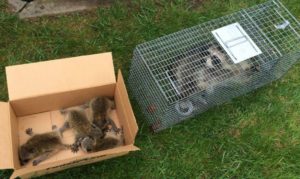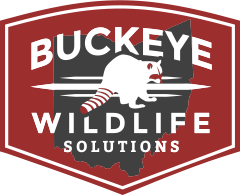 There are many tell-tale signs of spring beginning to arrive in Ohio; Days getting longer, a few warm days mixed with the gray late-winter ones, flowers and trees beginning to bud & bloom, and in the wildlife management field, the first litter of baby raccoons are found nestled up inside a homeowner’s attic. Raccoon breeding season is January-March, and after a 63-65 day gestation period, their young are born between late March and early April in the state of Ohio.
There are many tell-tale signs of spring beginning to arrive in Ohio; Days getting longer, a few warm days mixed with the gray late-winter ones, flowers and trees beginning to bud & bloom, and in the wildlife management field, the first litter of baby raccoons are found nestled up inside a homeowner’s attic. Raccoon breeding season is January-March, and after a 63-65 day gestation period, their young are born between late March and early April in the state of Ohio.
Buckeye Wildlife Solutions – Raccoon Maternity
Call: 844-544-9453
Right now, (Early March) pregnant female raccoons are looking for safe den sites to raise their young. Common places around homes that they choose include; attics, crawl spaces, chimneys, & under decks and sheds. When a female raccoon is seeking out her maternity area, she will want to be alone and away from male raccoons.
Adults can be heard in attics and crawlspaces mainly at night, walking around, scratching at drywall and wood, and rearranging insulation to make a bedding area. When baby raccoons are born, their vocalizations are very distinct. They are often described as sounding like baby birds chirping, but it is a moderately loud chatter that will be heard at various times of the day and night. This chattering is a prominent sign of raccoons in the attic.
Anytime you hear noises in the attic it’s a good time to call for an inspection, but particularly this time of year. Buckeye Wildlife Solution’s professional technicians will complete full interior and exterior inspections to outline what damage is present in the attic, followed by locating all points of entry by raccoons getting into your home. Live traps are placed at entry sites and monitored daily; until all raccoons are removed from your home. When a nursing female is caught, we will coordinate with the homeowner to get back into the attic to remove any young. We offer a variety of exclusion repairs to fix the areas where raccoons enter, which is essential to prevent further raccoon infestation in the attic.
The final step in the process is attic or crawlspace restoration. Urine and droppings left behind contain pheromones that are attractive to other raccoons. Droppings are especially hazardous due to the potential diseases that can result. Removal of contaminated insulation, disinfecting the attic, and replacing the insulation is crucial in preventing health risks associated with their feces as well as reducing the likelihood of continual raccoon issues.




